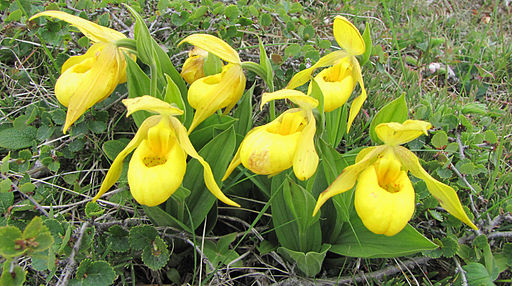Last weekend I drove with some friends to the Red River Gorge of eastern Kentucky for a wildflower walk organized by Father John Rausch, a Glenmary priest and ecological advocate. He arranged for Dr. Tom Barnes to lead us, the wildlife extension specialist from the University of Kentucky’s Department of Forestry and an accomplished nature writer and photographer.
This turned out to be much richer than we imagined. I’ve enjoyed many wildlife walks at national parks, seeing three times more than I would have seen on my own, taking home information that makes the forest vivid with specificity — no longer “tree, tree, tree” but “poplar, pawpaw, pin oak.” The tiny wildflowers, so easily overlooked, reward their viewers even more, especially since there are some we have often seen without remarking. If humans find it challenging to get to know other people without learning their names, it is all the more so for us with trees and plants.
There were nine of us. It rained all morning, but we circled the narrow roads, jumping out in ponchos and hiking boots to gaze at yellow and pink lady’s slippers (native orchids), Solomon’s seal, valerian, wild ginger, and a host of other flowers that in a couple weeks will disappear into the next stage in their plants’ annual cycles, while some other flower shows its stuff. Mute and mostly still, they nevertheless announce, to any audience and no audience, in their intricacy, variety, and beauty, their maker’s glory.
Since I know so little, each such outing doubles my memory bank, while reinforcing details from previous walks. To travel with a group small enough to ask, “What’s this?” yet large enough to share infectious zeal, made the day more festive still. We stayed in the moment: no one cared that it rained, and no one dampened our spirits by rehearsing their week’s troubles, many and varied as they were. The day’s sensory richness will long linger, cultivating affection for nature and commitment to its flourishing.
Inspired by this walk, I took my tree guide to a familiar meadow Sunday evening to catalog some specimens I often pass by. A farmhouse once stood here, and a floorless summer kitchen and outhouse still stand on the field edge next to some stray Stars of Bethlehem that someone may once have tended. It’s easy to imagine a clapboard home framed by youthful trees, which are now doddering past their prime: catalpas scantily clothed in last year’s seedpods and tentative spring leaves; sugar maples branching past their neighbors to hoard the sunlight; senescent slippery elms; black locusts, not yet blooming; white ashes past their bloom; an adolescent buckeye; a tulip magnolia someone left behind decades ago; a ghostly sycamore by the frog pond.
It’s hard to protect what we do not love. It’s hard to love what we do not know. And it’s hard to know what we do not stop to observe firsthand. The more we relearn nature, the more we’ll adjust our habits to assure its continuity. This is a sacred endeavor. As Sir Thomas Browne said (and I got this from Tom Barnes): “Nature is the art of God.”
This month’s lectionary is rich with Psalms and Old Testament texts (and the occasional Gospel story) celebrating God’s art in creation. Each of June’s five Sundays offers at least one passage that points, during a verdant month, toward what the ancients called God’s other book, the “book of nature.”
Here are passages that would most easily support a month of ecological preaching:
- Psalm 68:1-10, 32-35 (June 1) calls God the one who rides upon the clouds, and shows the heavens pouring down rain at God’s presence.
- Psalm 104: 24-35 (June 8, Pentecost) describes the multitude of earth’s creatures, “living things both small and great,” created by God’s spirit renewing the face of the ground, looking to God for their food, returning to their dust when they die.
- Genesis 1:1-2:4a (June 15) tells the grand creation story, complemented by Psalm 8, which observes “the heavens, the work of your fingers.”
- Genesis 21:8-21 (June 22) relates the story of Hagar and Ishmael, sent out to the wilderness, met by God and given both a promise for the future and water for present thirst.
- Matthew 10:40-42 (June 29), a fitting follow-up to Ishmael’s story, blesses whoever “gives a cup of cold water to one of these little ones.”
More subtle opportunities to point out creation’s role in the Bible and the life of faith are present in these:
- John 17:1-11 (June 1) defines eternal life as knowing God, and emphasizes Jesus’ work on earth.
- Acts 2:1-21 (June 8) uses wind and fire to describe the Holy Spirit, and describes meteorological events as harbingers of Jesus’ presence.
- Numbers 11:24-30 (June 8) relates Moses’ wish that all would speak prophetically and truly, guided by God’s spirit.
- 1 Corinthians 12:3b-13 (June 18) emphasizes the diversity of gifts given to all people, because though the body is one it has many members. The same is true for all members of the created community, who each play their crucial role, though some may be less well understood by us.
- John 20:19-23 (June 8) portrays the gift of the Holy Spirit to the disciples as human breath.
- John 7:37-39 (June 8 complementary) describes rivers of flowing water welling up from the hearts of believers.
- Psalm 69:7-10, (11-15), 16-18 (June 22 complementary) using a different water image, prays not to be swept away by enemies and floods, or swallowed up by the deep.
- Romans 6:1b-11 (June 22), using yet a third water image, describes baptism as burial into Christ’s death, in order to “walk in the newness of life.”
- Matthew 10:24-39 (June 22) describes God’s care for the sparrows.
- Jeremiah 28:5-9 (June 29 complementary) reminds us that the true prophets may not speak the words we want most to hear, though they speak more faithfully than those who cry peace.

